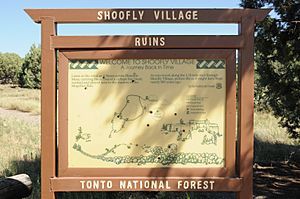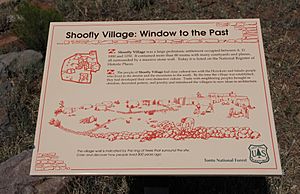Shoofly Village Ruin facts for kids
The Shoofly Village Ruin is an ancient archaeological site found in the Tonto National Forest near Payson, Arizona. It's like a time capsule showing us how people lived long ago.
Contents
Discovering Shoofly Village
In the 1980s, Arizona State University (ASU) started a big project called the Payson Archaeological Research Expedition (PARE). This project helped manage cultural sites and also taught students about archaeology.
Digging Up History
ASU teamed up with the Tonto National Forest. They chose the Shoofly Village Ruin as a special place for their field school. Students and experts worked there for four seasons, starting in 1984. They also explored other areas nearby.
What Were They Looking For?
The main goal was to understand how people lived in the Payson area. They wanted to see how Shoofly Village connected to smaller sites. These smaller sites often had just a few buildings, like two or three structures. They also found rock-ringed pits used for cooking and old farm fields.
Life in Shoofly Village
The Shoofly Village was built around the year 1000 CE. This was a time when the village grew a lot, and more people came to live there. People lived in Shoofly Village for about 300 years, until around 1300 CE.
A Book About the Past
A book called "People of the Tonto Rim: Archaeological Discovery in Prehistoric Arizona" by Charles L. Redman tells the story of ASU's work at Shoofly Village. Redman explains how different types of communities existed.
Types of Ancient Homes
- Household communities: These were small sites where just one family lived.
- Hamlets: These were a bit bigger than single family homes.
- Primary villages: These were the largest settlements.
Shoofly Village is the biggest of four known primary villages in the area. These large villages were spread out, each having its own area for growing food and gathering resources.
Shoofly's Special Spot
Shoofly Village was located in the northern part of the area. This spot was great because it gave people easy access to resources right below the Mogollon Rim. It was also close to a path that went up and over the rim.
How the Village Grew
Redman thought that Shoofly Village was made up of different groups of people joining together. Each group might have had its own way of building homes. The village was built in four stages.
Building Styles
The main part of the village had connected stone rooms. These were built later than the other parts, which had low walls made of stone and wood (called jacal). This suggests that different building styles might show when things were built, or even that different groups of people lived there. Other large villages in the area also had similar layouts and building histories.
Images for kids
















